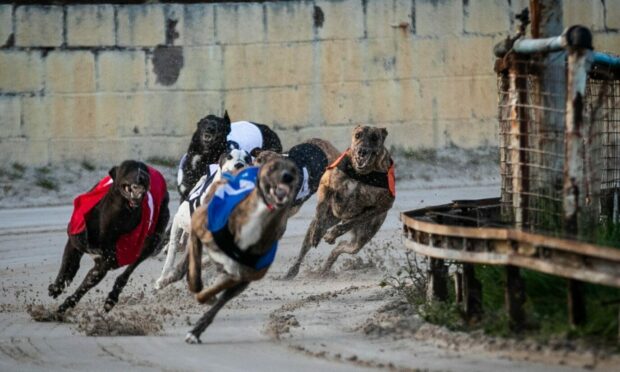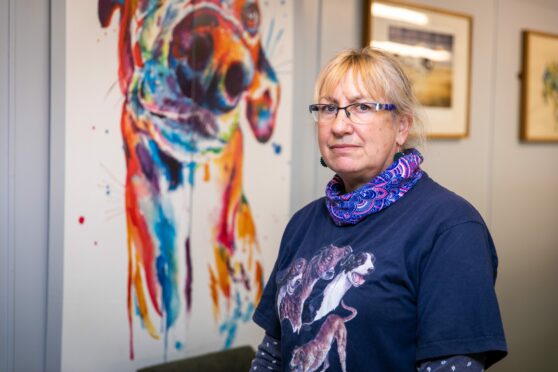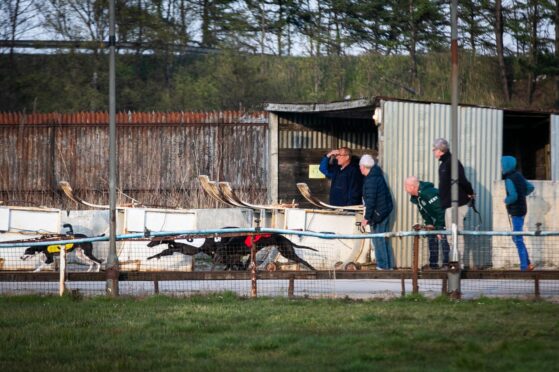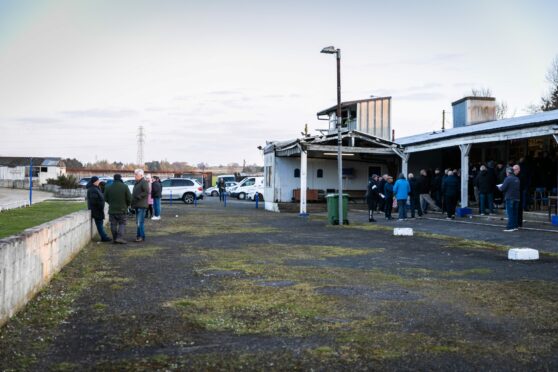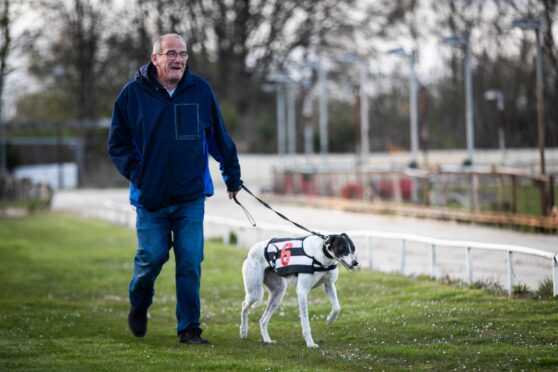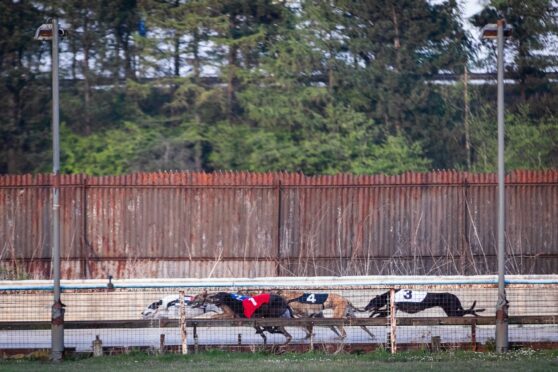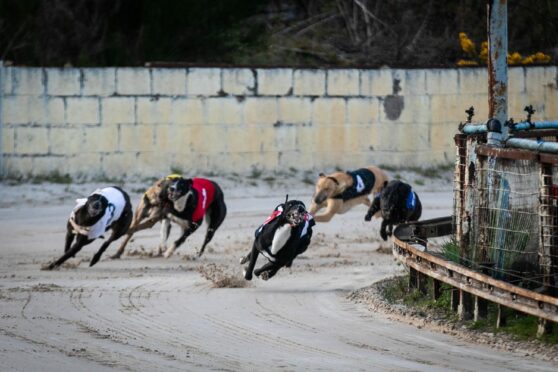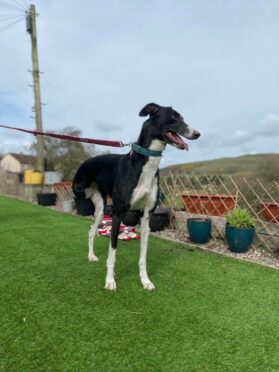Dog racing fans and greyhound owners have defended the sport, rubbishing claims the animals are poorly treated and drugged to make them run faster.
Last week campaign group Scotland Against Greyhound Exploitation (SAGE) took their calls for dog racing to be completed banned to MSPs at Holyrood.
The group says dogs are often poorly treated, are susceptible to horrific or even life-threatening injuries, and are sometimes drugged with cocaine.
There is only one dog track currently operational in Scotland – Thornton Stadium near Kirkcaldy in Fife – and the owners there strongly refute all of SAGE’s claims.
We went to Thornton on Saturday night to put those concerns to owners and enthusiasts watching races.
‘This is not exploitation’
Thornton Stadium has been operational since 1936 and is owned by Paul Brignal and Sandy Bingham for the past 20 years.
Speaking before the races kicked off, Ms Bingham said: “We always wanted to own a dog track.
“SAGE have been here twice but they are not allowed in.
“We don’t have much trouble with them and we try not to comment, but it is getting serious now because they are petitioning Holyrood.
“I don’t think this is exploitation, it just entertainment.
“We would be the only business affected by the ban, but there are a lot of trainers around here who will still go and race down south if it is banned.”
She heavily disputed any claims dogs were drugged with cocaine to make them go faster around the track.
Ms Bingham added: “No one would give a greyhound cocaine – they are pets for a start.
“The tests they do are really sensitive so if there was something on the handler the machines could pick that up.
“It is sensationalist.
“SAGE also says dogs are breaking their spines, but I have never seen that happen in 20 years.
“I’ve seen broken back legs and sprained muscles though.”
Thornton Stadium is currently not regulated by the Greyhound Board of Great Britain – something SAGE campaigners say is unacceptable.
However, Ms Bingham added they currently don’t have the funds to pay to join this board, which is why they are unregulated.
A night out at the dog races
There wasn’t a particularly large crowd at the race meet – probably around 60-80 people.
Ms Bingham told us most of the crowd were regulars who had been coming for years, and only a few years ago they would welcome hundreds to a race meet.
One of SAGE’s arguments for the sport to be banned is the fact the dogs are kept in their owners’ cars while they are not racing.
Thornton Stadium does not have any kennels available, and from what we could see this was the case – although a lot of the cars and vans had their boots and back seats converted for the dogs.
There was also one bookmaker taking bets for each of the races – fans there told us there used to be dozens of bookies, but as the popularity of the sport has dwindled, so too has those trying to make money out of it.
The dogs were racing around the track at around 40mph, chasing after a motorised hare (which at Thornton is actually an old hi-vis jacket).
Most of the races we saw, the dogs were clocking in times of around 16 seconds – one punter told us the record at Thornton is around 13 seconds, and this has stood for around two decades.
Dog owner defends dog racing
Robert travelled from Dundee to race his greyhound Roberta at Thornton.
He said there is no prize money involved in the race meet, but if a dog wins they get a trophy.
Speaking after one of Roberta’s races, he said: “I obviously want to see it staying.
“I have been in greyhounds for 40-odd years and the lies that come from the anti-brigade, saying the dogs are drugged and it is a cruel sport, is a load of rubbish.
“I have never forced Roberta to race, she just wants to go because it is a natural thing for greyhounds to want to chase anything that moves.
“At home she lies beside my lhasa apso and my pug, she is more of a pet than anything else.”
Robert also strongly denied the claims any of the dogs Roberta runs against are doped.
He added: “If anyone came in here with a dog all drugged and doped, they would get chased out of the place from genuine dog people.
“Years ago I was the dog warden in Dundee and I saw a lot of cruel cases, but genuine greyhound people don’t treat their dogs like that.”
‘One of the safest tracks in Britain’
We also spoke to a group of friends who had braved the cold to watch the dogs.
In fact, these friends have been going to the dog racing for years – one joked he was here watching the races before his father was even born.
Neil McGregor said: “This is one of the safest tracks in Britain.
“There is hardly ever a dog injured and I have been coming here for years.
“The greyhound boys look after their animals better than they look after themselves, the animals always come first.
“But the people who want to ban it stand outside and say it is cruel and all the rest of it.”
Jim Arnott added cases of dogs being drugged for racing only happened “years ago”.
He added: “You are going back years now – now dogs are always looked after like princesses.
“You watch Cheltenham and Aintree and the boys are on horses’ backs whipping them and then some of them never race again – here the greyhounds don’t get whipped and don’t have someone sitting on its back.”
SAGE say they will continue their fight
However, the SAGE campaigners are not giving up their fight to see greyhound racing banned in Scotland.
Although they were not at Thornton Stadium when we visited, they often hold small demonstrations outside the track on race nights.
Gill Docherty from SAGE said: “We saw inside Thornton Stadium on Wednesday and we’re deeply concerned about the state of the track and its surroundings.
“But what concerned us most was the owner Paul Brignal’s assertion that one in 10 dogs are injured on his track.
“This is almost nine times higher than the injury rate at the now-closed Shawfield Stadium in Glasgow.
“This confirms for the first time what we have long suspected that Thornton track is extremely dangerous for the dogs racing there, and as a society we cannot allow this animal abuse to continue.”
The group also want to see a complete ban rather than regulation for Thornton, saying regulation does not work effectively.
Ms Docherty added: “In the period 2017-2020 some 18,345 dogs were injured on GBGB tracks, and over 3,000 lost their lives.
“This is wholly unacceptable and completely unnecessary – this industry exists to serve the greed of humans who want to bet on the outcome of a race, but the dogs pay the price of that bet with their lives.”
Ms Docherty also sent us a photograph of three-year-old greyhound Joy.
She says Joy was rescued and rehomed in Fife in November 2021 after losing her leg while racing.
Ms Docherty added: “This is an extremely common injury due to an oval track putting uneven pressure on the limbs on the bends – most injuries happen on the first bend.”
